
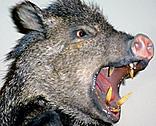
There are five groups of organic gems that are most often encountered in the gem and jewelry marketplace, or studied in gemology classes: pearls, amber, coral, ivory and jet. Pearls, amber, and coral are presently a major part of gem commerce (although the overfishing of coral is beginning to show). Ivory and jet are less common, and are most often seen in vintage or antique pieces. As all five have been covered in some detail in previous essays, it is my aim here to survey some of the rarer and/or lesser known organic materials that are currently, or have in the past been used for jewelry purposes.
In truth, some of the items listed here, fail to meet the "durability" criterion required for definition as a "gemstone", but have nonetheless been included due to historical interest or, to be honest, just because I think the're cool. :-)
Technically, teeth or small tusks are considered "ivory", but except for that from elephants and walrus few such items, are seen today. Many types were popular historically though, particularly in the Victorian Era. Rarer ivories include sperm and killer whale teeth, hippo teeth and perhaps most exotic, narwhal tusk. Trade in tooth and tusk ivory varies in legality depending on the species, the country of sale, and the age of the piece. Sale of boar tusks, and hippo teeth, for example, are unrestricted, whereas trade in whale, walrus and narwhal ivory is limited to native populations or certified antiques. Ivory artifacts are relatively durable due to their density and relatively high ratio of mineral to protein components.


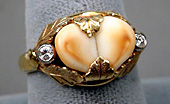
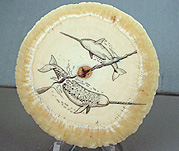
Structurally, this grouping has in common the presence of at least some keratin protein. Hair and claws are virtually all keratin while, horn, tortoise shell and antler vary in the degree to which the protein component has been "mineralized".
Certainly our remote ancestors made use of animal claws in their jewelry, but not too many examples have been prominent in Western culture in the last couple of centuries -- particularly not in settings of high karat gold. A notable exception to this is "tiger claw" jewelry seen sometimes in the antique market and hotly pursued by collectors. During the British colonial period in India, the wild tigers which are, so rightly, strictly protected in today's world, were seen as vermin of a particularly threatening kind. The "Sahibs'" tiger hunts were, at least to read British-authored historical accounts, much encouraged and appreciated by the native population. Taxidermists mounted heads, furriers made pelts, and jewelers set the claws in brooches and pendants.
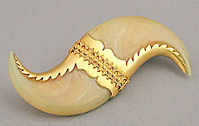
Horns from various species have been well known from both historical and current times as the source of useful objects such as cups and storage containers and handles for implements. In the jewelry world, horn is most often encountered in either the least expensive of tourist trinkets, or as an imitation of rarer materials, like jet or tortoise shell.

Antlers (which are conveniently shed yearly) have long been used for utilitarian and decorative purposes -- even the most casual collector of knives has at least one with antler adorning the handle or hilt. Antler has a ridged structure which makes it distinctive. The antler base, sometimes called the "button" or "flower" has also been used decoratively.

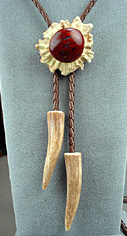
Human hair has in various times and cultures been used for jewelry purposes, but never as artistically and enthusiastically as in the US and Great Britain during the Victorian period. Perhaps you'd feel a bit squeamish about touching or wearing a vintage jewelry piece made from a dead person's hair. This was my initial reaction, but with time I've done a complete turnaround, and become an avid collector. Pieces range from simple locks of hair behind glass, or in a locket compartment, to elaborately woven works, and even "paintings" using strands of hair as the medium. Books of instructions and patterns for "hair work" were popular with young women of the time, and looms and other implements were sold to aid them. Such jewelry items were given as gifts between young lovers, or worn as remembrances of loved ones who had passed away. It was indeed a more sentimental age than ours.
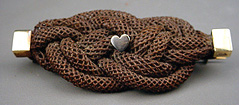
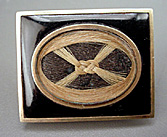
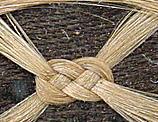
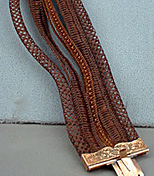

Human hair is not the only type found in jewelry. Those same British colonials who were sending home tiger claws in jewelry, also valued elephant hair (yes, that is a single hair!) in bracelets, necklaces, and rings.

Although we use the term "tortoise shell", in reality the carapace of a turtle or tortoise is actually not a bit like the shell of a mollusk, but is chemically and structurally most similar to horn. The term tortoise shell has come, in modern times, to stand more for a color pattern than a gem, and is seen almost exclusively in plastic imitations.
As they should be, the hawksbill sea turtles which are the source of gem tortoise shell are a protected species in today's world, but down through history their shell was used for furniture veneer, household implements, and hair ornaments as well as for jewelry.
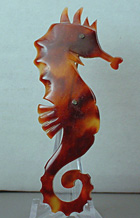
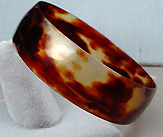
The natural thermoplastic properties of tortoise shell made possible a unique art form which dates back to the 1700's called "pique". Pieces of silver or gold were heated and pushed into a piece of tortoise shell, which would then shrink around the metal as it cooled, holding it in place, enabling the production of simple to amazingly complex patterns.

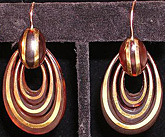
Whales are divided into two basic groups depending on their feeding mechanism, called the toothed and the baleen whales. Baleen whales feed by straining huge mouthfuls of water and extracting small crustaceans and other edibles. Their "strainers", called baleen, hang from the upper jaw and can be yards long. Each fringed plate is made of a flexible proteinaceous substance very similar in composition to horn or tortoise shell. Baleen historically had many industrial and domestic uses (including the "whalebone" in lady's corsets), but it was, and still is, used for art objects and jewelry. Presently, only Native Americans whose traditions include whaling can legally harvest and use these whales' parts, including baleen.
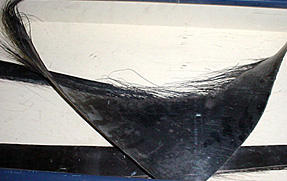

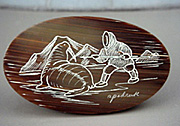
One of the rarest of all organic gem materials is known as "hornbill ivory" or golden jade, but it is neither ivory nor jade. It is a proteinaceous horn-like material obtained from the "casque" or secondary bill, of the Kenyalang or Helmeted Hornbill bird from Borneo, now rigorously protected. Only certified antiques such as those below can legally be traded. In earlier centuries this material which ranges from a creamy white to translucent golden yellow was used for ornamental and jewelry purposes particularly throughout the Orient. Most valued was the outer "rind" of the bill which was stained a bright red-orange from glandular secretions rubbed into it by the bird's preening activities.
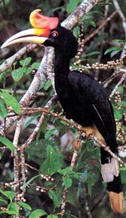
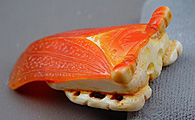
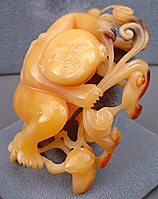
What we commonly call pearls are irritant-induced secretions of mollusks which are covered with lustrous nacre (a combination of aragonite or calcite and conchiolin protein). They were once highly valued products available only from Nature, but the 20th century and Mr. Mikimoto, the cultured pearl king, changed all that. Humans now routinely force certain species of captive oysters and mussels to produce gem pearls. Other mollusks, however, form substances loosely referred to as "pearls", but technically known as calcareous concretions, as they lack nacre. Gem quality non-nacreous pearls (conch pearls, scallop pearls and melo melo pearls) are rare collectors items which have their own unique beauty. They have a shiny, porcelain-like surface and are produced in various shapes and colors. By far the rarest (although to my eye not the most beautiful) are the marble and larger sized pearls from the giant baler or melo melo snail -- a fine specimen can bring tens of thousands of dollars!


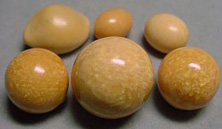
An interesting oddball jewelry item, sometimes called the "Pacific Cat'seye Pearl" is likewise not a pearl, but a calcified protein secretion of a South Seas snail known as the Turban shell. Technically it is called an operculum and functions as a kind of "trap door" to seal off the snail's soft body from harm. Many species produce them, but the eye-like marking, and naturally cabochon-like shape of the Turban shell's operculum makes it special. Throughout many centuries, visitors to the South Seas, and sailors returning from there brought home trinkets featuring this exotic gem.
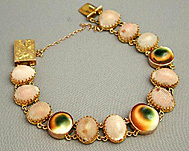
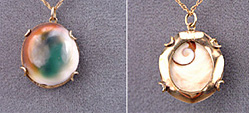
With the exception of entomologists, few find much of beauty in the insect world. Surprisingly, though, insects have had their part to play in the saga of jewelry history. Once again it is the Victorians who most exploited this resource. The stylized form of the scarab beetle has since earliest historic times been memorialized in faience, metal and gemstone jewelry, yes, but during that period known as the Egyptian Revival, the actual insect itself was a popular jewelry item. After being carefully dried, and possibly coated with a thin layer of lacquer, they were used for brooches, earrings and pendants of surprising durability. Insect wings have also been used, especially those of butterflies and moths in creating "paintings" and jewelry items, these, however, generally had to be encased in glass or plastic in order to be wearable.
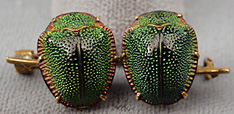

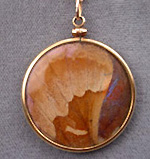
Shagreen is the tanned hide of sharks and certain rays. It has a long history as an ornamental material from Japanese Shogun era sword hilts, to French Revolution era furniture veneers, to Art Deco jewelry. It is beautiful, relatively durable, and has a unique, bumpy texture that inspires devotion in many collectors.

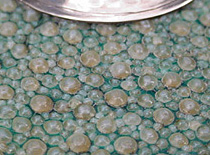
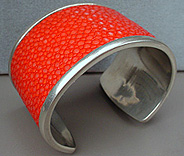
Of the friends and acquaintances who have been invited to view my collection of odd organics, the object below is the one most often singled out as supremely hideous! Personally, I find it has a sort of Charles Bronson-esque loveable ugliness. This early 20th century item is a grouse foot brooch (yes, it is a real foot), and was lovingly made with sterling silver and foilback paste "topaz" gems in Scotland. To each his own, but I always smile picturing some kilt-clad kinsman of mine (my maiden name is Walker) wearing this good luck token during his grouse hunt through the heathered hills.
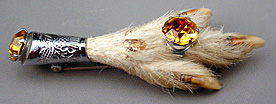
Little can be said that applies equally to all the specimens shown here. A biological rule of thumb however, is that if it is an organic molecule, like protein, something eats it. Organic gems containing, or made of, protein (and that is most of them) should be kept dry, and when not being worn or used, protected from exposure to insect, bacterial or fungal invaders. This may mean keeping treasured antique pieces in vacuum sealed bags, or in boxes with "moth crystals". Proteinaceous materials are also sensitive to heat and can be ruined by temperatures that wouldn't begin to phase a mineral gem.
The calcareous types such as the conch pearl, are, like their more familiar nacreous cousins, sensitive to heat and chemicals. Additionally most organics should be protected from prolonged exposure to strong light to prevent loss of color which is generally derived from fragile organic pigments.
As with virtually all gems, size, color and freedom from flaws set value within a particular type. When dealing in antiques and art objects, the age, quality, and condition are the premier value points.
From modestly priced and common antler or horn items to stratospherically expensive, vanishingly rare hornbill ivory or melo melo pearls, the world of unusual organics is one that every gem lover and collector, no matter what their budget and tastes, can and should enjoy.